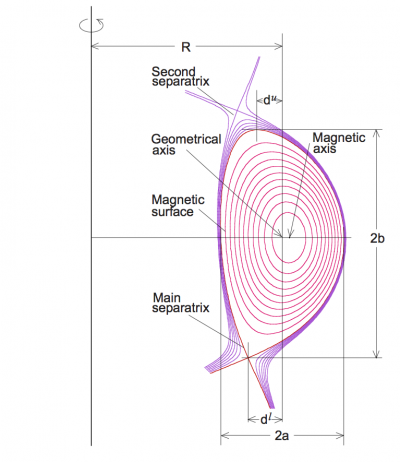Triangularity: Difference between revisions
Jump to navigation
Jump to search
No edit summary |
No edit summary |
||
| Line 6: | Line 6: | ||
* ''R<sub>geo</sub>'' is the geometric major radius, defined as ''(R<sub>max</sub> + R<sub>min</sub>)/2''. | * ''R<sub>geo</sub>'' is the geometric major radius, defined as ''(R<sub>max</sub> + R<sub>min</sub>)/2''. | ||
* ''a'' is the minor radius of the plasma, defined as ''(R<sub>max</sub> - R<sub>min</sub>)/2''. | * ''a'' is the minor radius of the plasma, defined as ''(R<sub>max</sub> - R<sub>min</sub>)/2''. | ||
* ''R<sub>upper</sub>'' is the major radius of the highest vertical point of the LCFS. | * ''R<sub>upper</sub>'' is the major radius of the highest vertical point of the LCFS or separatrix. | ||
* ''R<sub>lower</sub>'' is the major radius of the lowest vertical point of the LCFS. | * ''R<sub>lower</sub>'' is the major radius of the lowest vertical point of the LCFS or separatrix. | ||
The upper triangularity is then defined as follows: | The upper triangularity is then defined as follows: | ||
:<math> \delta_{upper} = (R_{geo}-R_{upper})/a</math> | :<math> \delta_{upper} = (R_{geo}-R_{upper})/a</math> | ||
Revision as of 15:24, 17 June 2014
The triangularity refers to the shape of the poloidal cross section of the Last Closed Flux surface (LCFS) or separatrix of a tokamak. Assuming[1]:
- Rmax is the maximum value of R along the LCFS or separatrix.
- Rmin is the minimum value of R along the LCFS or separatrix.
- Rgeo is the geometric major radius, defined as (Rmax + Rmin)/2.
- a is the minor radius of the plasma, defined as (Rmax - Rmin)/2.
- Rupper is the major radius of the highest vertical point of the LCFS or separatrix.
- Rlower is the major radius of the lowest vertical point of the LCFS or separatrix.
The upper triangularity is then defined as follows:
and similar for δlower. The overall triangularity is defined as the mean of δupper and δlower.
See also
References
- ↑ T.C. Luce, Plasma Phys. Control. Fusion 55 (2013) 095009

